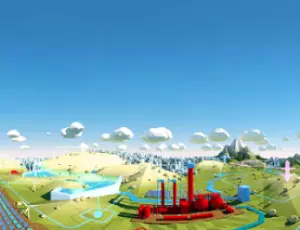Smart steering of energy consumption, enhancing the value of energy in urban environments, vegetalisation and biomimicry… A number of initiatives to decarbonize the construction sector are bringing a new conception of energy – digitalized and decentralized to the fore.
The sparing use of energy is not the construction sector’s strong point. Today, the sector accounts for over 40% of the total energy consumption in France. Reducing this figure represents a challenge that will be all the more tricky as energy demand is destined to rise in the decades to come. With the effect of the demographic explosion, growing middle classes and economic growth, among other things, it is expected that energy demand will rise by 30% globally by the year 2040.
“Future requirements should be anticipated ecologically,” says Christophe Nebon, director of Veolia’s Energy France business. “To date, heating was the crux of the problem in the energy sector. Tomorrow, we should be focusing on the quality of air, which is becoming a growing source of concern for inhabitants, as well as air conditioning buildings, when you learn that GIEC, the UN intergovernmental group of experts on climate evolution, forecasts that temperatures will reach 50°C in Paris in the summer of 2050.” With climate deregulation and the multiplication of heat waves, the number of air conditioners could well rise from 1.6 billion to 5.6 billion by 2050.
Cooling buildings without heating up the planet
The main challenge will be to produce “virtuous” cold without having recourse to individual air conditioners as much as possible. The cooling challenge of creating a cool atmosphere must be approached at neighborhood or city level rather than per building. This is the objective of cold networks, which aim to “pool energy production and consumption on a neighbourhood scale, rather than using individual air conditioners” explains Christophe Nebon. These networks – there are around 20 in France today – are formed of one or several energy production units and operate a distribution circuit in which heat transfer fluid circulate, and to which buildings can be connected.
The solution is pertinent to democratize access to cold and produce cold (or heat), especially when these urban networks are fuelled by renewable or alternative energy: geothermics, biomass, cogeneration, the enhancing of energy contained within waste water…“In the face of climate changes, urban cooling will be a long-term project, to create synergies among buildings or neighborhoods and enhance the value of currently unexploited sources of cold,” says Pierre-Antoine Picard, director of Veolia Energy projects in France.
“pool energy production and consumption on a neighbourhood scale, rather than using individual air conditioners”
Smart building
Once decarbonized, tomorrow a building’s energy will be increasingly digitalized. At Veolia, energy saving means “smart building” or connected buildings. Its smart steering center, known as Hubgrade, enables clients (in the public, service and industrial sectors) to follow their energy consumption in real time. The goal is to optimize energy performance, namely by activating installations at the most opportune times without affecting their inhabitants’ comfort and to enable clients to make guaranteed savings on their energy bills.
“Whereas until now customers had an overall view of their consumption, they can now visualize their consumption activity by activity, or appliance by appliance”, points out Gregory Sanchez, Veolia sales director in Belgium and Luxembourg.“It is a transparent tool that enables us to intervene very quickly if there is a consumption or operation anomaly. Thanks to this tool, we can detect a problem instantly, whereas beforehand, the anomaly might appear only after two or three days.”
The platform can reduce an energy bill by an average of 15% and accompanies the alternative production of local energy: “When customers wants to be autonomous, Hubgrade can provide them with continuous measuring tools and modulate the production of energy in line with their needs,”he explains.
Natural plant-based insulation
Of course, improving energy performance only has any meaning when a building is well insulated. The eradication of “thermal sieves” represents a substantial challenge in France, where the government aims to have 35 million homes renovated in the name of the “low consumption building” label (BBC in French) by 2050. There is no lack of ecological innovations in the sector. Green roofs, notably, provide a natural insulation that allows for a 10% to 15% reduction in energy consumption, while at the same time absorbing the CO2 in the atmosphere through photosynthesis. Data that can now be measured thanks to building information modeling (BIM), which models and optimizes a construction project digitally before the building work, by calculating its environmental footprint and its energy performances.
“Green roofs, notably, provide a natural insulation that allows for a 10% to 15% reduction in energy consumption”
Other observers dream of a biomimicry architecture that can reproduce the ventilation and heat regulation techniques of a termite mound. In Harare, in Zimbabwe, the architect Mick Pearce has developed a 90% autonomous building, which can do entirely without air conditioning: small partitions open to the outside of the building regulate the indoor temperature just as the holes in a termite mound do, according to the magazine L’ADN. All these possibilities, that combine high- and low-tech, are a sure sign that cities in the future will be smarter and guarantee well-being and eco-responsibility.

In partnership with Usbek & Rica, the media that explores the future.



